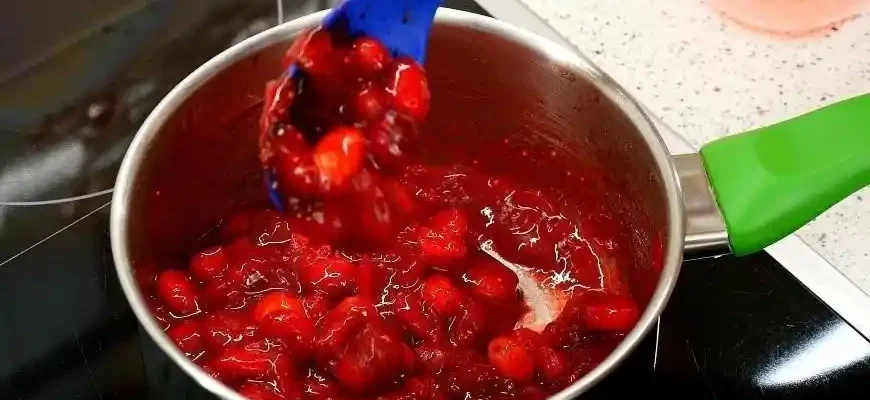Cranberry sauce is a classic accompaniment to holiday meals, particularly in the United States, where it’s served alongside turkey during Thanksgiving. But its tangy flavor and vibrant color have made it a popular addition to many other meals throughout the year. If you’ve never made cranberry sauce from scratch, or if you’re simply looking for ways to improve your recipe, you’ve come to the right place.
In this guide, we’ll explore everything you need to know about making cranberry sauce: the ingredients, the process, and even some tips and tricks to ensure it comes out perfectly every time. Plus, we’ll take a look at some important considerations, like nutritional value and dietary preferences, to make sure everyone can enjoy it.
The Basics of Cranberry Sauce
Cranberries are small, round berries that grow on low-lying vines, typically in cool climates. These tart fruits are rich in antioxidants, vitamin C, and dietary fiber. They’re also naturally low in sugar, which makes them ideal for use in sauces, jams, and juices.
Cranberry sauce traditionally includes just a few ingredients:
- Fresh or frozen cranberries
- Water
- Sugar (usually white or brown)
- Optional flavorings like orange zest, cinnamon, or cloves
Some variations might include a splash of fruit juice, like apple or orange, for added sweetness and complexity. Others might mix in herbs, such as rosemary, or even spirits like bourbon or brandy for a more sophisticated touch.
Step-by-Step Guide to Making Cranberry Sauce
- Gather Your Ingredients
- 1 bag (12 oz) of fresh or frozen cranberries
- 1 cup of water
- 3/4 cup of granulated sugar (or more if you prefer it sweeter)
- 1/2 cup of orange juice (optional)
- 1 tablespoon of orange zest (optional)
- A pinch of ground cinnamon or whole cinnamon stick (optional)
- 1-2 tablespoons of fresh chopped rosemary (optional for a savory twist)

- Prepare the Cranberries
If you’re using fresh cranberries, rinse them well in cold water. Pick through them to remove any soft or damaged berries. Frozen cranberries can be used directly from the freezer, no need to thaw them. - Cook the Sauce
In a medium saucepan, combine the cranberries, water, and sugar. If you’re using any optional flavorings like orange juice, zest, or spices, add them now. Bring the mixture to a boil over medium-high heat. - Simmer
Once boiling, reduce the heat and let it simmer for about 10-15 minutes. You’ll notice the cranberries starting to pop and soften. Stir the mixture occasionally to prevent it from sticking to the bottom of the pan. Continue simmering until the sauce thickens to your liking. If you prefer a smoother sauce, you can mash the cranberries with a potato masher or use an immersion blender for a more consistent texture. - Cool and Serve
Once your cranberry sauce has thickened, remove it from the heat and let it cool. The sauce will continue to thicken as it cools, so don’t worry if it seems a little runny at first. Serve it at room temperature, or refrigerate it for later use.
Tips for Perfect Cranberry Sauce
- Adjust Sweetness: Cranberries are naturally tart, and everyone has different preferences when it comes to sweetness. If you find the sauce too tart, try adding a little more sugar or even honey, maple syrup, or a pinch of stevia. For a lower sugar version, you can also substitute sugar with a sugar substitute like monk fruit or erythritol.
- Add Spice: Traditional cranberry sauce is relatively simple, but don’t be afraid to experiment. A cinnamon stick can add a warm depth of flavor. For something a bit more exotic, consider adding a pinch of ginger, nutmeg, or allspice.
- Go Savory: If you’re pairing your cranberry sauce with a savory dish, like a pork roast or stuffing, try adding fresh herbs, such as rosemary or thyme, to the mix. A splash of balsamic vinegar can also balance the sweetness with a rich, tangy note.
- Texture Preferences: Some people like their cranberry sauce smooth, while others prefer it chunky. If you’re making it for a crowd, consider offering both! To make a smooth sauce, blend it with an immersion blender. For a chunkier version, simply let the cranberries break apart naturally during cooking.
- Storage: Homemade cranberry sauce will keep in the refrigerator for up to a week and can also be frozen for up to three months. Just make sure it’s stored in an airtight container to prevent freezer burn.
Nutritional Information and Health Benefits
Cranberry sauce, especially when homemade, can be a great addition to your diet. Cranberries themselves are packed with antioxidants and are particularly known for their role in urinary tract health. However, keep in mind that cranberry sauce made with a lot of sugar can become a more indulgent treat rather than a health food.
For those looking to lower the sugar content, it’s easy to modify the recipe by using less sugar or substituting with a healthier alternative. Also, if you’re following a low-carb or keto diet, there are low-carb sweeteners available that can work well in this recipe.

The Social Side of Cranberry Sauce
While cranberry sauce is often linked to Thanksgiving and other holiday feasts, its versatility means it can be enjoyed year-round. It pairs beautifully with roasted meats like turkey, pork, or chicken, and can even be served as a topping for salads, grilled cheese sandwiches, or savory pies.
That being said, there are a few things to consider when preparing cranberry sauce for different audiences. Some people might not be fans of the tartness, while others may prefer a sweeter version. It’s important to know your guests’ preferences—or, better yet, offer both a sweet and savory version to cover all the bases.
Common Issues and Solutions
- Too runny: If your cranberry sauce turns out too thin, don’t panic. You can always simmer it for a few more minutes to allow it to thicken. Alternatively, add a little cornstarch or arrowroot powder dissolved in water to the sauce to thicken it quickly.
- Too sweet: If you’ve overdone the sugar, a squeeze of fresh lemon or a splash of vinegar can help balance the flavors.
- Too tart: For those who find cranberries too sour, adding a little extra orange juice or a sweetener like honey can tone it down.
What People Are Saying About Cranberry Sauce
- Maria (45, United States): “I’ve been making cranberry sauce for years, but I finally tried adding a little bit of bourbon this year. It added such a rich depth of flavor! My family loved it, and I’ll definitely be doing it again next year.”
- Ahmed (52, Egypt): “In our family, we’ve never really eaten cranberry sauce, but I tried making it for a Western-style dinner and it was a hit. I reduced the sugar because we prefer less sweetness, and it turned out great!”
- Tanya (63, Canada): “I’ve always made cranberry sauce from scratch, and my secret is adding a few cloves and a dash of cinnamon. It gives it a warm, spicy kick. It’s always the star of the meal!”
- Luca (30, Italy): “I thought cranberry sauce was only for Thanksgiving, but after trying it with roast pork, I’m a fan for life. I like to add a little balsamic vinegar to cut the sweetness, it works perfectly!”
- Yuki (28, Japan): “I made cranberry sauce for the first time when I moved to the US. I didn’t expect to like it, but the tartness and sweetness together were a perfect complement to turkey. I add orange zest for a little extra zing!”
Final Thoughts
Cranberry sauce is not just a holiday tradition, it’s a versatile dish that can be adapted to fit a variety of tastes and dietary preferences. Whether you like it sweet or savory, smooth or chunky, this simple yet flavorful sauce is easy to make at home and will add a burst of color and flavor to any meal. Don’t be afraid to experiment with different ingredients to make the recipe your own, and remember to have fun with it!









